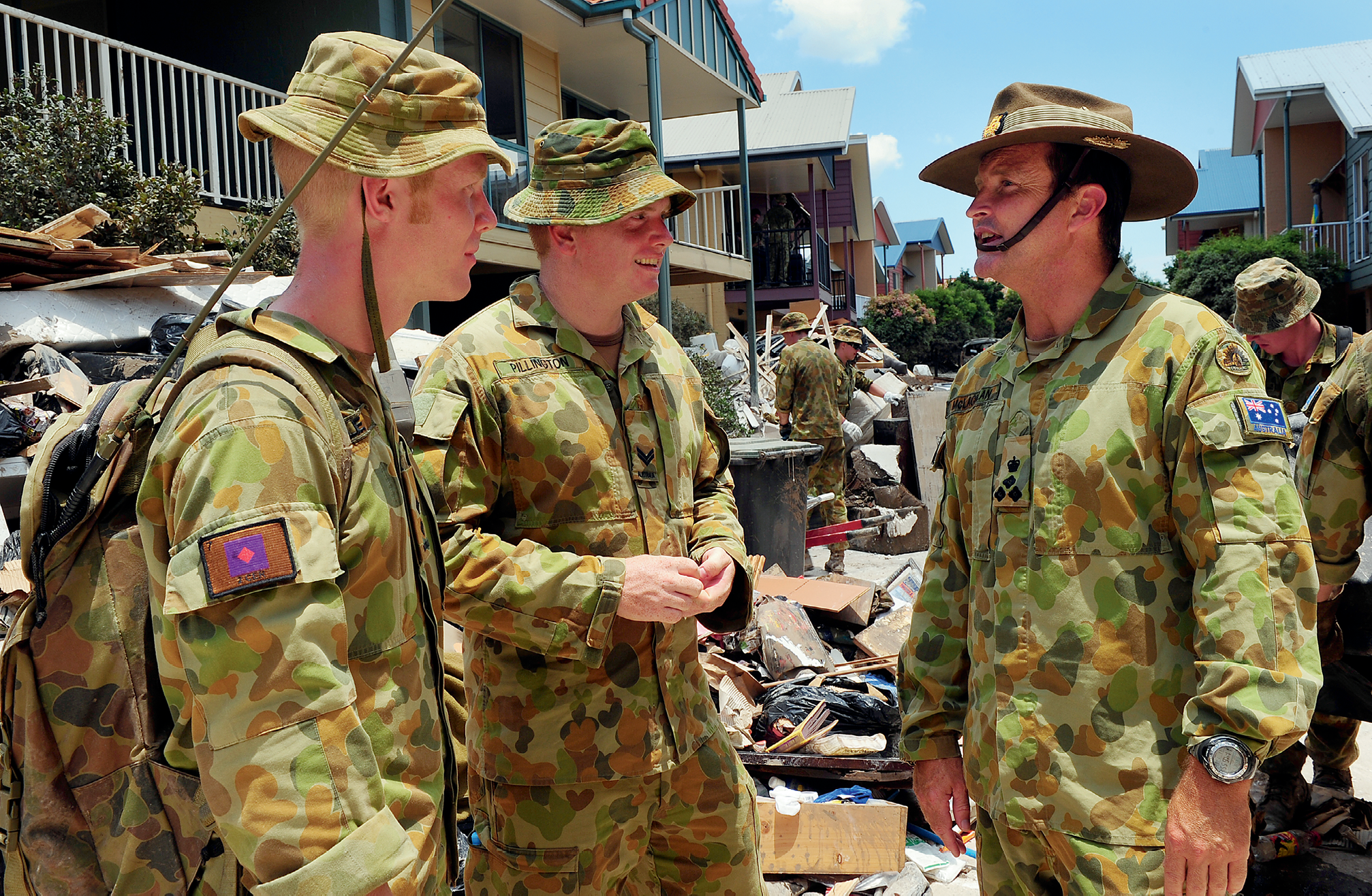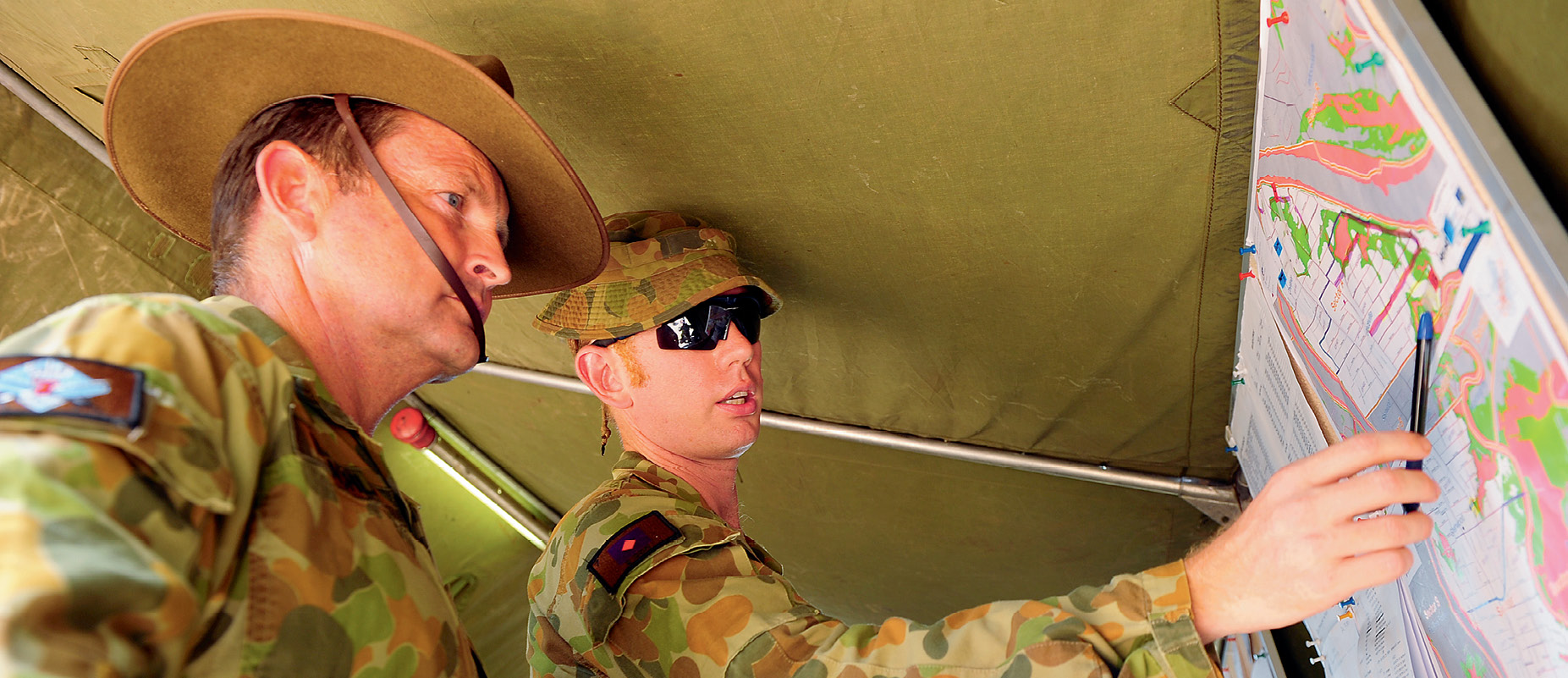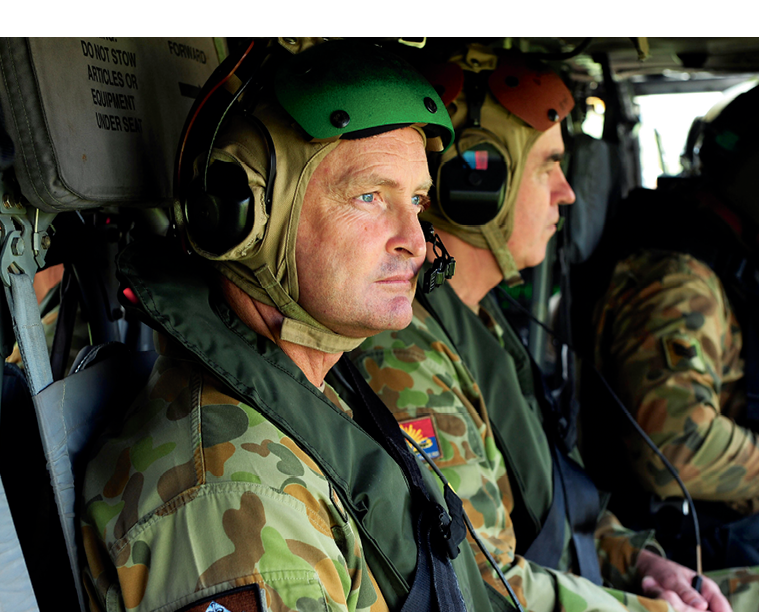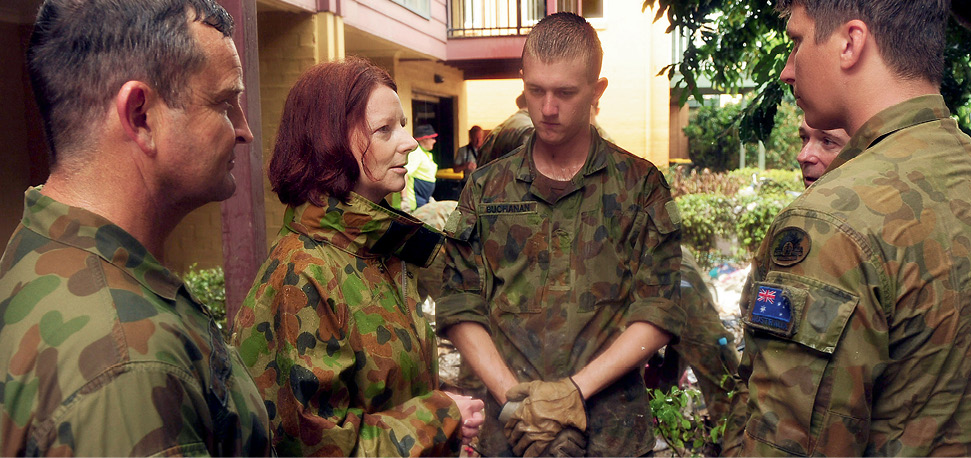
To Queensland flood victims, the site of a dozen soldiers willing to strip their sodden house and take the rubbish away must have been a relief.
On 17 January–one week after the worst of the floods raged through the Lockyer Valley, and days after the waters inundated Brisbane’s suburbs–Brigadier Paul McLachlan took command of the Australian Defence Force’s Operation Queensland Flood Assist taskforce, leading a joint outfit of 1900 troops from the Army, Navy and Air Force as a contribution from the Australian Government, to help Queenslanders start to get back on their feet.

Credit: Corporal Janine Fabre
Brigadier Paul McLachlan, Commander, Joint Task Force 637 meets troops working hard with the clean-up effort in Fairfield, Brisbane.
It emerged from an original deployment of about 300 troops who helped in the initial response phase, and it became the biggest deployment of personnel on home soil since Cyclone Tracy–when the Army rotated through 2000 soldiers during its four-month effort to help Darwin rebuild.
The ADF’s contribution to the Sunshine State’s Natural Disaster Resilience Program this year included more than 19 aircraft, engineers, divers, trucks and other equipment as well as its instant, large and highly-capable workforce who turned up with pickaxes and shovels, just as families were returning to their devastated homes and wondering where to start.
“Having that support at the very worst time certainly I think helped a lot of people and we were very pleased to be able to do it,” Brigadier McLachlan says.
The ADF also contributed its unique way of looking at things.
“I suppose it’s a mindset,” Brigadier McLachlan says. “We are serial planners in the military, we just can’t help ourselves. We would rather write a plan than just react to circumstance.
“If you’re in a conflict situation, you can’t afford to be just reacting, you’ve got to actually be trying to change the situation proactively, so that you bring pressure to bear on your adversary.
“We know that if we haven’t got a plan up front that we can execute faster than our adversary, then we are just reacting–and that’s something the military tries to avoid. Reacting is bad. Reacting means you’re coming second,” he says.
Brigadier McLachlan says this way of thinking helped him figure out how the ADF could be of the best possible help to Queensland in its recovery phase. He had three days to prepare before taking over the command from Colonel Luke Foster.
“That allowed me to pull all of my people in and develop a plan, set up our liaison system. Then we were in a really good position to start that reconstruction effort then and make sure all the people we were dealing with actually knew what we were bringing and what our capabilities were,” Brigadier McLachlan says.
“Having a lot of experience working in places like East Timor and the Solomons, as the higher conflict places, it’s just organisation and that capacity to develop a plan and then execute it, that was really useful.”
The ADF did not take charge of the recovery effort, but worked as part of the emergency management framework–performing tasks that state, regional and local disaster coordinators wanted Defence to do, he says.
Brigadier McLachlan describes the experience of working this way as “a singular pleasure. Everybody just came together and concentrated on getting things done,” he says.
Last year was a rough one for Brigadier McLachlan’s Brisbane-based 7th Brigade. It lost six soldiers in Afghanistan. He says the support the Brigade members felt from the Queensland community in 2010 made them more determined to help the state in its time of need.
“When we recalled people from leave to come in and help, we were very conscious that we had guys who had just come back from Afghanistan from a very difficult deployment, and we were trying to leave them alone and at home with their families.
“They just turned up. They just came in and said, ‘we want to help’. Despite our best intentions, we couldn’t stop them,” he says.

Credit: Corporal Janine Fabre
Major Lee Bowden from 2nd Combat Engineer Regiment (2CER) briefs Brigadier Paul McKachlan, Commander of Joint Task Force 637.
Brigadier McLachlan said while the emergency response organisations had good plans in place, the addition of a Defence resource gave those in charge some ‘space’.
“A lot of the commanders we sent have combat experience and a lot of them have been about planning and about trying to get distance between ourselves and the problem,” he says.
“My experience is, that for people dealing for the first time with a real crisis, you can get caught up in the reaction/counter-reaction pace. What you actually need to do is build an organisation where you’ve got people who are dedicated to managing those immediate responses, but you have to have, separate from those, people saying ‘ok, what’s likely to be happening in the next 36 hours? what do we need to get ready for?’ So you can get ahead, so you’re not going to have a whole range of crises rolling on the ground.”
A good example of this, he says, was the evacuation of the Cairns Base Hospital, ahead of Cyclone Yasi.
“When people thought the eye of the cyclone was going to go straight over it, they were concerned the hospital might not survive, so a decision was made in enough time to get those people out,” he says.
In the days after Brisbane flooded, a navy vessel fitted with sonar equipment surveyed shipping channels, in Morton Bay and the Brisbane River.
Brigadier McLachlan says this was to ensure the channels were clear of any hazards that would prevent, for example, fuel vessels reaching Brisbane so there was no chance the city would run out of fuel.
Clearance diving teams were also used up and down the Brisbane River, to identify any hazards to ships.
“We found 154 major contacts and we gave those coordinates to Queensland maritime authority so they could deal with them,” Brigadier McLachlan says.
“They were things like sunken pontoons, a few boats, there was a trawler that sank.”
“Another preemptive step Defence was able to provide was to pre-position water purification units in isolated communities, to prevent a future health crisis,” Brigadier McLachlan says.
By the end of last year, Queensland had experienced its wettest spring and December on record and even at that stage one of its most significant floods in history. Its own resources were stretched and the state sought Australian Government help from the Australian Government’s Department of Defence through the Attorney-General’s Department Emergency Management Australia Division. The ADF’s Operation Queensland Flood Assist began on December 28.
During its various phases, under Colonel Foster, and then Brigadier McLachlan, Defence personnel performed rescues, airlifted people to safety, and delivered medical supplies, food and more than two million litres of purified water. They collected aerial imagery, helped sandbag properties, cleaned, door-knocked, and provided environmental health teams as well as psychological support teams to help the Queensland Government.
They also performed the grim task of searching for bodies. Brigadier McLachlan says in total, more than 300 personnel, with vehicles and helicopters, searched 500km up and down Lockyer Valley river systems. The troops covered the difficult terrain twice, to satisfy coroner’s requirements.
Brigadier McLachlan’s operation was carried out in three stages. It began with a surge, to do what was needed as early as possible. This involved more than 1000 people in Brisbane, 400 in Ipswich, 300 in Grantham, plus special aviation and maritime task groups.
As the crisis eased, the role turned to more specialised capabilities, using engineers to pull 150 cars from Murphy’s Creek at Grantham and clear 22,000 tonnes of debris. Eventually, it concentrated on the worst hit areas, such as the Lockyer Valley, that needed the ADF for the longest. The joint taskforce ended on 5 February but 300 personnel, including an engineer task group and image analysis team remained until 16 March. Major General Mick Slater was continuing to chair the Board of the Queensland Reconstruction Authority at the time of writing.

Credit: ABIS Jo DiLorenzo
Commander Joint Task Force 637 and Chief of Army, Lieutenant General Ken Gillespie, AO, DSC, CSM fly over flood affected SE Queensland in a Blackhawk helicopter.
In the weeks and months surrounding the Queensland floods, the Australian Government, through the ADF, also provided help in the West Australian bushfires and Carnarvon floods, the Victorian floods, Cyclone Yasi, the Christchurch earthquake and the tsunami in Japan.

Credit: ABIS Jo DiLorenzo
Prime Minister, The Hon. Julia Gillard, MP with Commander of Joint Task Force 637; Queensland Flood Assist, Brigadier Paul McLachlan speaks with soldiers participating in the flood clean-up effort in Brisbane Suburbs.
Brigadier McLachlan says although the situation in Queensland was horrendous, the spirit of those involved in the response–from civilians to emergency service managers–was remarkable. It made the task all the more satisfying.
“Certainly for the soldiers, you couldn’t keep them away with a pickaxe handle,” Brigadier McLachlan says.
“They were amazed at just how hard all of these guys (residents) were working so soon after such a catastrophic event to get their lives back in order and it just inspired them and made them want to help."
“It started a whole lot of new relationships and generated a whole lot of understanding and in doing that, everybody involved in that process has seen a whole lot of new opportunities for us to work together better and I think that only bodes well to a better response next time.” As for the local opponent, the mighty force of nature, he says: “That’s a particularly hard adversary to second guess.”

Credit: ABIS Jo DiLorenzo
Prime Minister, The Hon. Julia Gillard, MP and dignitaries disembark the Sea King helicopter to visit affected suburbs of Brisbane.